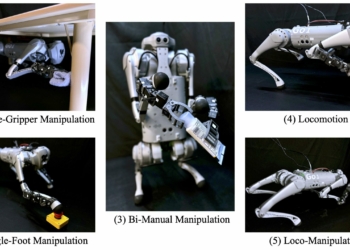A new cancer study reports that DNA manifested as knot-like folds and third rungs between DNA’s two strands may drive cancer development and an important regulatory enzyme could be associated with the formation of these unusual structures.
Scientists from Northwestern Medicine and the La Jolla Institute for Immunology (LJI) have discovered that the loss of TET enzymes — a family of enzymes crucial for removing DNA methylation marks — is associated with B-cell lymphoma. Reduced activity of TET enzymes is common in many different cancers. Understanding the mechanisms behind cancer development upon loss of TET function may open the door for new drug treatment strategies to target multiple cancers.
The research was recently published in the journal Nature Immunology.
Previous research demonstrated specific mutations in cancer cells can result in loss of TET function in patients with blood cancers and solid cancers, causing delays in cell communication. Past studies have also identified genomic instabilities such as double-stranded breaks in the DNA code in cancer cells.
Before now, the two dangerous cell features had not been linked.
Strange, unusual structures appear in the DNA
Vipul Shukla, an assistant professor of cell and developmental biology at Northwestern University Feinberg School of Medicine, along with Anjana Rao, a professor in LJI Center for Cancer Immunotherapy, and Daniela Samaniego-Castruita, a University of California San Diego graduate student, hoped to explore one potential way TET deficiency and genomic instability may be connected.
“Loss of TET function happens in cancer; genomic instability happens in cancer,” Shukla said. “Genomic instability also happens in TET-deficient cells. What we found was that altered regulation of secondary DNA structures might be the reason for how these two events are related to one another.”
The scientist first deleted two types of TET enzymes (TET2 and TET3) in mature B cells of mice. A type of white blood cell, B cells make antibodies for the immune system to protect our bodies from infection. According to Shukla, deleting TET enzymes had huge implications on the homeostasis of B cells, and genomic instabilities began to appear.
“The TET-deficient mice developed lymphoma, and we observed an increase in marks associated with genomic instability, such as double-stranded breaks,” Samaniego-Castruita said.
The team then looked for clues to what was happening at the molecular level by performing a genomic analysis and found that without TET2 and TET3, unusual structures called G-quadruplexes and R-loops started littering the DNA of B cells.
Typically, DNA looks like two parallel train rails. As proteins move along the track and read through and communicate code, they pull the tracks slightly apart. But both DNA structures appeared to make it difficult for the cell to read DNA code. R-loops, made of RNA, slipped in as a third rail in DNA, and G-quadruplexes appeared as knots on the outer rails, making it difficult for the original strands to “unzip.”
According to Shukla, the structures make DNA sites very fragile and breakable.
“They function as impediments in the DNA and if they don’t resolve properly, they cause genomic instability,” Shukla said. “This study enlightened us that at least one of the reasons TET-deficient cells have more genomic instability might be due to the accumulation of these structures.”
Understanding how dangerous genomic instabilities and telltale TET mutations interact brings the team a step closer to understanding B cell malignancies.
Delaying the development of B-cell lymphoma
Shukla said he wanted to know why the structures appeared in the first place because then his team could learn more about stopping them from forming. They looked to one regulatory enzyme called DNMT1 that appeared to change in response to TET levels.
In TET-deficient B cells, levels of DNMT1, proteins that helps maintain DNA methylation, were higher. DNA methylation is an important regulatory mark in the genome that is typically removed by TET enzymes.
The team wanted to see if deleting the DNMT1 protein in TET-deficient B cells would restore the balance of G-quadruplex and R-loop structures.
Remarkably, deleting DNMT1 was linked to a stark delay in the development of aggressive B-cell lymphomas. As hoped, it also was associated with decreased levels of G-quadruplexes and R-loops.
The researchers plan to further explore the effects of TET enzymes and believe that regulating G-quadruplexes and R-loops may be one of many ways TET enzymes control genomic stability. In the future, the findings of the paper could be used to help patients across cancer types.
Shukla’s lab ultimately hopes to see how drugs can stabilize the abnormal structures and work as an effective treatment for malignant cells in many cancers. Shukla said there is lots of potential, and lots more to learn.
“The structures are like black boxes,” Shukla said. “Because normally when you think about DNA, you think of a linear code with four letters. But this is asking you to think about not just the sequence itself, it’s also the way DNA can fold into alternative conformations besides the double helix. This study sheds light on a new aspect of genome biology.”
Recently joining Northwestern from LJI, Shukla and his lab focus on studying alternative structural conformations in the DNA.
The study, “TET deficiency perturbs mature B cell homeostasis and promotes oncogenesis associated with accumulation of G-quadruplex and R-loop structures,” was supported by the National Institutes of Health (NIH) (grants S10OD016262, S10RR027366, DP2-NS105576, S10OD025052, 2500 S10OD016262, R35 CA210043, R01 AI109842, AI128589 and K99/R00 CA248835); the NIH National Cancer Institute (grant CA248835); a Leukemia and Lymphoma Society Postdoctoral Fellowship (grant 5463-18); CONACYT/ UCMEXUS fellowships; research funds from LLS grant 5463-18; and The Tullie and Rickey Families SPARK Awards for Innovations in Immunology Program.
The researchers used resources of the Advanced Light Source at Lawrence Berkeley National Laboratory, which is a DOE Office of Science User Facility under contract number DE-AC02-05CH11231.
Additional study authors include Zhen Dong, Edahi Gonzalez-Avalos, Qingqing Yan and Kavitha Sarma.













